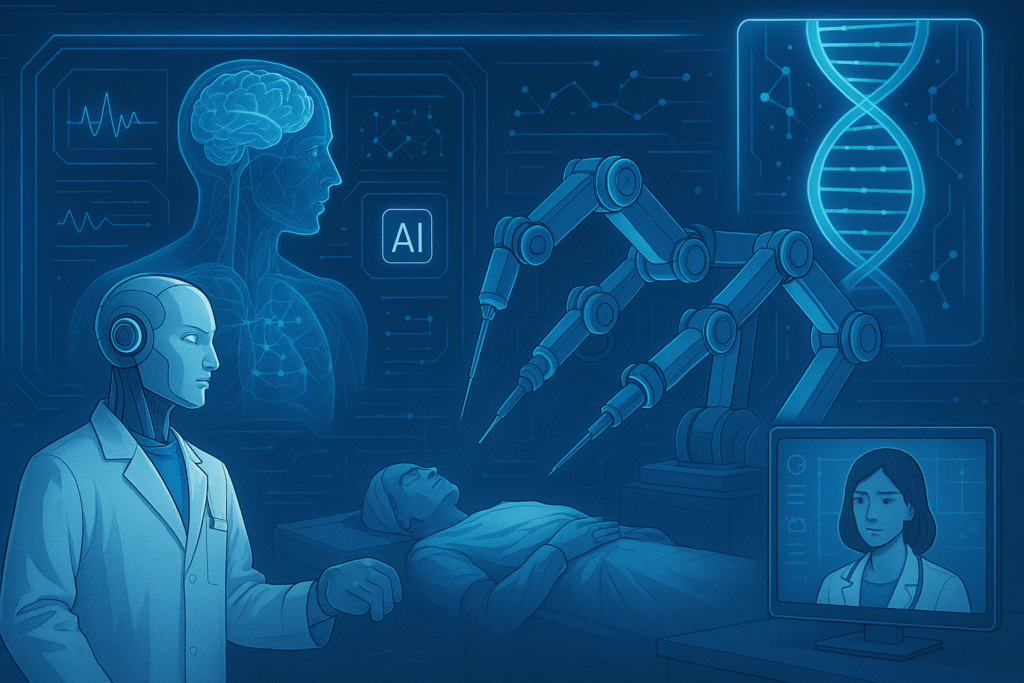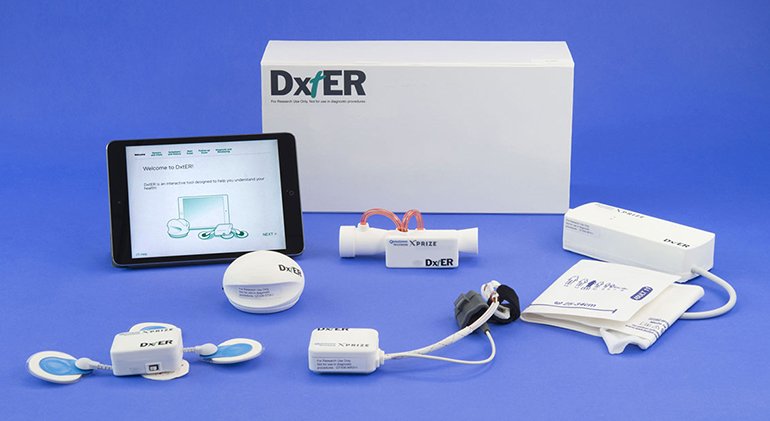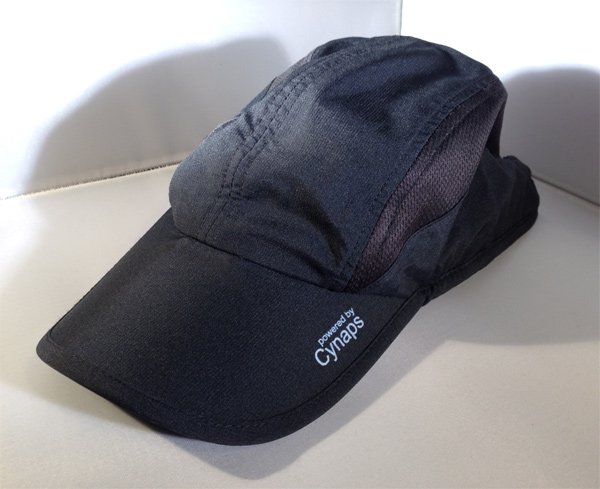This is GizmoMD
Dear Friends, It’s been a while. If you’ve been wondering what happened to Medgadget — you’re not alone. It’s been a few years since anything was published, and like many of you, I’ve missed the excitement of discovering and sharing the latest in…
The Latest
Scientists Shape Sound into Holograms to Gently Stimulate the Brain
Scientists at NYU Langone and ETH Zurich have developed a remarkable new method for stimulating specific brain circuits using sound—shaped not just into waves, but into actual holograms. Their device looks a bit like a helmet and contains 512 ultrasound emitters, which fire in sync to form complex patterns like triangles or pentagons. These geometric holograms travel through the skull and target precise brain networks without requiring any surgery or implants, marking a major advance in noninvasive brain therapy. The technique is called transcranial ultrasound stimulation (TUS), and it works by sending gentle sound pulses into the brain that activate…
Minimally Invasive Surgery Breakthrough: New Robotic Heart Valve Procedure
Surgeons at Cleveland Clinic have successfully performed the world’s first heart valve replacement using a combination of robotic surgery and a newly designed artificial valve. The procedure involved implanting Corcym’s Perceval Plus® sutureless aortic valve through a small incision at the base of the neck, using CardioPrecision’s CoreVista® Robot Enabling Platform. This approach—known as AVATAR (Advanced Videoscopic Aortic Valve Surgery by Transcervical Approach using Robot Assistance)—marks a major step forward in minimally invasive cardiac surgery. Unlike traditional open-heart surgery, which requires splitting the sternum, this transcervical technique offers a much less invasive alternative. Patients are expected to experience less pain, faster recovery, and minimal scarring.…
Dental Floss Could Deliver Vaccines Without Needle
In a breakthrough that blends everyday hygiene with cutting-edge immunology, researchers at North Carolina State University have developed a novel method for vaccine delivery—through dental floss. The technique utilizes unwaxed dental floss coated with vaccine material, which is gently threaded between the teeth and gums. It targets the junctional epithelium, a thin, porous tissue at the gumline that connects oral surfaces to the immune system. This unique interface is highly permeable and teeming with immune cells, offering an ideal site for triggering protective responses without piercing the skin. In lab experiments, mice that received a flu vaccine via floss showed…
Israeli Scientists Study Bacteria in Space to Improve Infection Treatment
Researchers at Sheba Medical Center in Israel have launched a groundbreaking medical experiment to the International Space Station (ISS) to study how space conditions affect disease-causing bacteria. The project, developed by Sheba’s ARC Innovation Center and Infectious Diseases Research Laboratory in partnership with U.S.-based space tech company Space Tango, is part of NASA and SpaceX’s Crew-11 mission. It aims to uncover how microgravity influences bacterial gene expression—especially traits related to virulence and antibiotic resistance. This is Sheba’s second space-based experiment. The first, conducted in 2021, revealed that bacteria exposed to simulated space conditions were less able to acquire antibiotic resistance…
Light-Sensitive Materials That Help Electronics Think Like the Brain
Researchers at Forschungszentrum Jülich and RWTH Aachen University have developed a new type of electronic material that mimics how the brain processes information—using light instead of electricity. These materials, called organic photoelectrochemical transistors (OPECTs), are designed to behave like synapses, the tiny connections between nerve cells that allow us to learn, remember, and adapt. The brain’s synapses strengthen or weaken over time depending on how often they’re used. This ability to change is what makes learning and memory possible. Scientists have long tried to replicate this behavior in electronics—a field known as neuromorphic engineering—to build devices that can “think” more like humans.…
Smart Dressing Heals Burns Faster and Safer
Researchers at the Shenzhen Institutes of Advanced Technology (SIAT), working with Ruijin Hospital, have developed an advanced wound dressing that could greatly improve healing for burn victims and trauma patients. It’s made from bacterial cellulose, a breathable and skin-friendly material, and enhanced with human-derived thrombin, a natural protein that helps blood clot quickly. By fusing these together, they’ve created a dressing that doesn’t just cover wounds—it actively promotes healing. Traditional methods for stopping bleeding, such as electrocautery, can cause further damage to delicate tissue. In contrast, this new dressing stops bleeding in less than a minute, as demonstrated in lab tests using rat liver wounds.…
Algorithmic Advances: A Monthly Recap of AI in Healthcare (July 2025)
Artificial intelligence may not be a classic “gizmo,” but it’s become an undeniable, rapidly evolving force in healthcare. From streamlining clinical workflows to flagging anomalies in imaging, algorithms are working their way into nearly every corner of medicine. The jury’s still out on just how useful, safe, or transformative these tools will ultimately be. But there’s no shortage of momentum—or headlines. So here’s a curated look at some of the most noteworthy AI-in-medicine developments from the past month. 🔮 Predictive and Personalized Medicine Meet Your Digital Twin: This AI Model Can Predict Your Future Health (Weizmann Institute of Science) AI predicts…
Dual-Mode Optical Imaging System Enhances Skin Cancer Diagnosis
Researchers from Saint-Étienne University Hospital and Paris-Saclay University, in collaboration with Damae Medical, have developed a compact imaging system that combines line-field confocal optical coherence tomography (LC-OCT) with confocal Raman microspectroscopy. This dual-mode approach enables noninvasive diagnosis of skin cancer by capturing both structural and chemical data. LC-OCT provides high-resolution cellular images of skin tissue, while Raman microspectroscopy analyzes molecular composition. Over a year-long clinical study, the system was tested on 330 nonmelanoma skin cancer samples, including basal cell carcinoma and squamous cell carcinoma. Researchers collected over 1,300 Raman spectra and trained an AI model to classify cancerous structures. The…
Wearable Platform Harvests Ambient Light for 24-Hour Health Monitoring
Researchers from the Korea Advanced Institute of Science and Technology (KAIST) have developed a next-generation wearable platform that enables continuous health monitoring using ambient light as its primary energy source. The system integrates three complementary technologies—photometric, photovoltaic, and photoluminescent methods—to minimize battery use and extend device operation to 24 hours. The photometric system adjusts LED brightness based on surrounding light, reducing power consumption by up to 86%. The photovoltaic system uses high-efficiency solar cells to harvest energy indoors and outdoors, while an adaptive power management module selects among 11 modes based on battery status and light availability. The photoluminescent layer…
Smart Wound Monitor Tracks Healing with Reusable Sensors
Engineers at RMIT University have developed a wearable wound monitoring device that uses integrated sensors to track healing indicators like temperature, pH, and inflammation—without requiring dressing removal. The device connects via Bluetooth and is designed for reuse, making it more cost-effective and scalable than disposable smart bandages. Chronic wounds affect millions globally and cost Australia’s healthcare system $3 billion annually. Traditional wound care involves frequent dressing changes, which can delay intervention and increase infection risk. The RMIT device conforms to curved surfaces and uses biocompatible materials that integrate seamlessly into existing manufacturing workflows. Researchers estimate the cost could drop below…


















